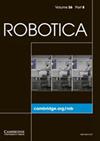Self-adaptive learning particle swarm optimization-based path planning of mobile robot using 2D Lidar environment
IF 2.7
4区 计算机科学
Q3 ROBOTICS
引用次数: 0
Abstract
The loading and unloading operations of smart logistic application robots depend largely on their perception system. However, there is a paucity of study on the evaluation of Lidar maps and their SLAM algorithms in complex environment navigation system. In the proposed work, the Lidar information is finetuned using binary occupancy grid approach and implemented Improved Self-Adaptive Learning Particle Swarm Optimization (ISALPSO) algorithm for path prediction. The approach makes use of 2D Lidar mapping to determine the most efficient route for a mobile robot in logistical applications. The Hector SLAM method is used in the Robot Operating System (ROS) platform to implement mobile robot real-time location and map building, which is subsequently transformed into a binary occupancy grid. To show the path navigation findings of the proposed methodologies, a navigational model has been created in the MATLAB 2D virtual environment using 2D Lidar mapping point data. The ISALPSO algorithm adapts its parameters inertia weight, acceleration coefficients, learning coefficients, mutation factor, and swarm size, based on the performance of the generated path. In comparison to the other five PSO variants, the ISALPSO algorithm has a considerably shorter path, a quick convergence rate, and requires less time to compute the distance between the locations of transporting and unloading environments, based on the simulation results that was generated and its validation using a 2D Lidar environment. The efficiency and effectiveness of path planning for mobile robots in logistic applications are validated using Quanser hardware interfaced with 2D Lidar and operated in environment 3 using proposed algorithm for production of optimal path.基于自适应学习粒子群优化的移动机器人二维激光雷达环境路径规划
智能物流应用机器人的装载和卸载操作在很大程度上取决于其感知系统。然而,在复杂环境导航系统中对激光雷达地图及其 SLAM 算法进行评估的研究却很少。在拟议的工作中,利用二进制占位网格方法对激光雷达信息进行微调,并采用改进的自适应学习粒子群优化(ISALPSO)算法进行路径预测。该方法利用二维激光雷达映射为物流应用中的移动机器人确定最有效的路径。机器人操作系统(ROS)平台采用了 Hector SLAM 方法来实现移动机器人的实时定位和地图构建,随后将其转化为二进制占位网格。为了展示拟议方法的路径导航结果,利用二维激光雷达测绘点数据在 MATLAB 二维虚拟环境中创建了一个导航模型。ISALPSO 算法根据生成路径的性能调整其惯性权重、加速系数、学习系数、突变因子和蜂群大小等参数。与其他五种 PSO 变体相比,ISALPSO 算法的路径更短、收敛速度更快,计算运输和卸载环境位置之间的距离所需的时间也更短。使用与二维激光雷达连接的 Quanser 硬件,并在环境 3 中使用建议的算法生成最佳路径,验证了物流应用中移动机器人路径规划的效率和有效性。
本文章由计算机程序翻译,如有差异,请以英文原文为准。
求助全文
约1分钟内获得全文
求助全文
来源期刊

Robotica
工程技术-机器人学
CiteScore
4.50
自引率
22.20%
发文量
181
审稿时长
9.9 months
期刊介绍:
Robotica is a forum for the multidisciplinary subject of robotics and encourages developments, applications and research in this important field of automation and robotics with regard to industry, health, education and economic and social aspects of relevance. Coverage includes activities in hostile environments, applications in the service and manufacturing industries, biological robotics, dynamics and kinematics involved in robot design and uses, on-line robots, robot task planning, rehabilitation robotics, sensory perception, software in the widest sense, particularly in respect of programming languages and links with CAD/CAM systems, telerobotics and various other areas. In addition, interest is focused on various Artificial Intelligence topics of theoretical and practical interest.
 求助内容:
求助内容: 应助结果提醒方式:
应助结果提醒方式:


